Drosophila Genomics Resource Center was recently awarded a five-year, $2.7 million grant by the National Institutes of Health as a continuation of the grant that established the center in 2003. The DGRC is one of three world-class, federally funded facilities on the IU Bloomington campus that support the use of fruit flies in research.
Fruit flies (Drosophila) and humans are genetically similar, sharing nearly 10,000 genes, thus making Drosophila a model organism for biomedical research. Much of what is known about the function of genes has been learned through Drosophila research.
The DGRC acquires, archives, curates, and distributes essential genetic tools to researchers. It also supports the development of improved techniques for Drosophila research and works to generate new resources to benefit fly researchers.
“We service not only the domestic research community but also the international research community,” said Associate Professor Andrew Zelhof. “People across the whole spectrum of biology are using our resources, and this award will help us continue to do this for another five years.”
Zelhof became director of the DGRC in 2016.
“IU has been very supportive of Drosophila research for a really long time,” he said. “As home to three centers, IU Bloomington is commonly referred to as the Drosophila capital of the world by biologists.”
The other two centers are Bloomington Drosophila Stock Center and FlyBase. BDSC maintains a living stock collection with over 63,000 (the number continues to grow) genetically defined strains of D. melanogaster. The strains are shipped to researchers around the globe. FlyBase maintains the world’s most comprehensive database of fruit fly DNA sequence information.
Zelhof noted that having all three centers on campus is helpful towards IU’s undergraduate education mission. Around eight labs in IU Biology rely on tools and resources from all three centers. Opportunities for undergraduate students to participate in Drosophila research are possible because of the centers.

 The College of Arts
The College of Arts